| Chapter 5: Was the Vetter BSA project the reason Don left BSA? Don's words in black; Craig's in blue | |||||||||||||||||||||||||||||||||||||||||||||
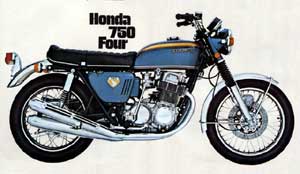 | Don summarizes: Despite all of the good efforts in the east and the west, the BSA and Triumph triples were not a huge success in the market place. | ||||||||||||||||||||||||||||||||||||||||||||
| Just after our success at Daytona, Honda dropped their bombshell by introducing the CB 750, a near perfect bike for its time. It was a four cylinder, five-speed, overhead cam beauty. | |||||||||||||||||||||||||||||||||||||||||||||
| Then, if that wasn’t enough, the chairman decided to reorganize. I was put in charge of BSA sales for the US, and the chairman asked me to assist one Peter Thornton -- an MIT graduate ad man who knew nothing about motorcycles or the industry -- to close down BSA, sell property we had purchased to build a new facility, and merge with Triumph in the East. Supposedly, these measures would save the Group from disaster through more "professional" management and advertising (Thornton was an advertising consultant with InterPublic, the largest advertising agency at the time), but history proved otherwise. I sold the BSA property for the new facility at twice the amount I paid for it. The Chairman sent me a cable that said, “You are in the wrong business - thank you.” That was my last official act for BSA. | |||||||||||||||||||||||||||||||||||||||||||||
| The Vetter BSA was in England For Seven Months Oct 1969 and May 1970 | |||||||||||||||||||||||||||||||||||||||||||||
| Don continues: Years later, the late Pete Colman, formerly vice president for engineering of the merged BSA and Triumph company, told me he had seen Craig’s prototype in the basement of Umberslade, the Group R&D research center. Craig comments: If this was true, it would have been in that seven-month period the Vetter BSA was in England, from October 1969 through May 1970. Steve Mettam would have been working on it, wouldn’t he? Don answers: I simply don’t know because I was no longer at BSA for most of that period. According to Pete, he made a proposal to use the BSA engines and frames that were left over when the BSA division went bust, to build a limited-production special that could be sold at a premium price. Those were the magic words: "at a premium price." Apparently, Craig’s original gamble had paid off! Craig recalls: My last recorded phone conversation with Don Brown was January 5, 1970 when Don explained that Lionel Jofeh was here now to see Thornton. Don asked me to draft a Project Summary in order to help him get the project accepted so I could be paid. I did, and mailed it to him. On or about January 8, 1970, I was informed by Patty Wayngrecht that Don had left the company. Surprise! I never understood until now why Don left. Don explains: I resigned my position in January of 1970. Peter Thornton and I were nearly fighting by then. I realized too that I failed to keep you posted as to what was going on, although I now know that Harry Chaplin and Don Bridgette, the Midwest BSA sales rep, and perhaps others thought they knew what was going on and were probably telling you what they thought was occurring. I returned to California and started my own business with offices in the Hilton Pasadena. | |||||||||||||||||||||||||||||||||||||||||||||
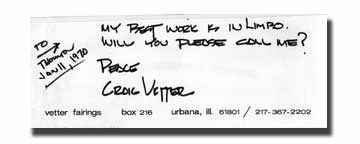 | |||||||||||||||||||||||||||||||||||||||||||||
| Craig comments: Nobody told me anything. In fact, I was being stonewalled. I wrote to Peter Thornton directly on January 11, 1970, asking for payment. | |||||||||||||||||||||||||||||||||||||||||||||
| ("Peace" is how some of us 'trendy' hip guys signed our letters in those days) | |||||||||||||||||||||||||||||||||||||||||||||
| Don remembers: Eric Turner called me at my office in Pasadena one morning to ask me whether or not I had executed a valid contract with Craig. I told him the contract was valid and after a brief reflection on BSA affairs, he said he would arrange for Craig to be paid. Pete Colman’s secretary, Ruth Furman, also had called me a few days before the chairman to ask me if I had a copy of the contract I had signed with you. I said I had a copy but it was still somewhere in my archives from the move. Actually, I wasn’t certain I still had a copy but I was prepared to testify that my contract with you was a valid obligation of BSA, Inc. Craig: I received my check for $12,000 March 9, 1970. Don continues: Mr. Turner (Eric) was an honorable man whom I liked very much despite his unwillingness to listen to his American managers and his propensity to hire senior executives who had no experience with the motorcycle industry. Not long after that, the BSA Group filed for receivership. I am glad Craig was paid -- albeit a smaller sum than was earned -- before the Group collapsed. But I doubt it was the money that motivated Craig. It’s more likely that his recognition for having created a truly unique and original design was more than enough payment. | |||||||||||||||||||||||||||||||||||||||||||||
| Where did the name “Vetter BSA “come from? | |||||||||||||||||||||||||||||||||||||||||||||
| Craig: I put that name “Vetter / BSA” on the bike’s license plate. The name stuck. | |||||||||||||||||||||||||||||||||||||||||||||
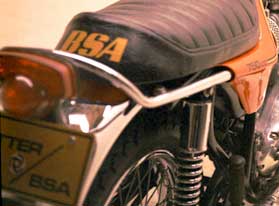 | 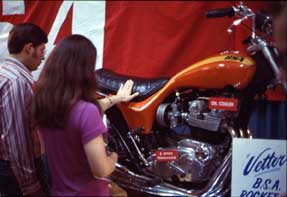 | ||||||||||||||||||||||||||||||||||||||||||||
| BSA called it the “Vetter BSA Rocket 3” in 1971 at Houston. | |||||||||||||||||||||||||||||||||||||||||||||
| Motorcyclist magazine in its July, 2004 issue just named the Hurricane as: "One of the Ten Sexiest Motorcycles of All Time" It is probably because it invites you to "Pet me" | |||||||||||||||||||||||||||||||||||||||||||||
| As late as August of 1972, Bert Hopwood refers to it in his book as the “BSA Vetter Rocket.” It wasn’t until October, 1972 that the name "X-75 Hurricane appeared." I liked the name "Hurricane" because it continued the heritage of British airplane names. I suspected that Don liked it too. Craig continues: Before he left BSA, Don Brown had arranged with Joe Parkhurst to feature my design on the cover of Cycle World with a feature article, but the bike first had to be brought back from England for refurbishing. The original Vetter Rocket 3 model arrived through Chicago customs on May 7, 1970. I drove to Chicago and picked it up. In my Notebook # 12, p 9, I wrote: "The bike was in very rough shape and many pieces were missing. I had three days to make new pieces and fix this thing. On Monday, May 11, I returned the bike to Chicago where it was air freighted to Cycle World in Los Angeles. Duane Anderson (who helped fabricate the original metal parts on the model) and I flew out on May 21, 1970 to be interviewed by Dan Hunt, managing editor of Cycle World. Duane Anderson and I picked up new Kawasaki 500s to ride home to Illinois. | |||||||||||||||||||||||||||||||||||||||||||||
| Craig continues: The bike appeared on the famous September 1970 "white cover" issue of Cycle World with the caption, "Is this the next BSA 3?" Joe Parkhurst, founder and editor, later told me that this was by far the most popular edition of CW to date and that all extra copies were sold out also. After the photo shoot for Cycle World, the bike was displayed in their lobby for a while. Between January 29-30, 1971, BSA displayed the Vetter Rocket 3 at the Houston Astrodome trade show, and then it was stored in Anaheim by my friend, Darryl Bassani, until he delivered it to me in Illinois. | |||||||||||||||||||||||||||||||||||||||||||||
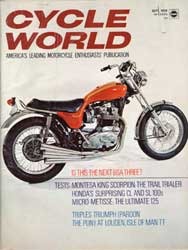 | 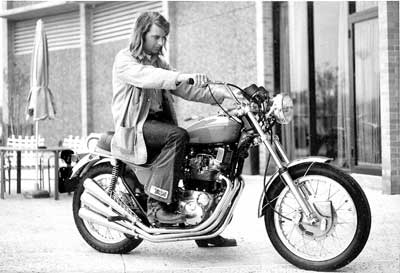 | ||||||||||||||||||||||||||||||||||||||||||||
| Is this the next BSA 3? | |||||||||||||||||||||||||||||||||||||||||||||
| A year later, on January 29, 1972 I was invited to Houston for a special presentation of the new bikes. From my notebook # 16: "I saw the Rocket 3 in a truck yesterday and was very impressed with it. I took lots of pictures." So this was it and it was really happening! This bike still said BSA on it and still had the "750cc" name on the side, just as I had designed it, not the "X-75" as on production bikes. They still referred to it as the "Vetter Rocket 3." There were no labels saying "X75" nor did anyone call it a "Hurricane.” "We planned a limited production edition of a BSA 'Vetter Rocket,' a variation of the triple cylinder machine but with a vastly different appearance. It had been styled by Craig Vetter, a young American, to appeal to what I can only describe as the ‘trendy' type of rider whose numbers were increasing fast in the States ( p. 265)." Bert didn’t get it. He should have because Ex Chairman Edward Turner said in 1973: "Machines sell on the whims of fashionable young men. These fads are constantly changing." | |||||||||||||||||||||||||||||||||||||||||||||
| Craig continues: In 1978, after Joe Parkhurst sold Cycle World, I hired him to write the story of the Triumph Hurricane. A thousand copies of "A Hurricane Named Vetter" were printed, one for each of our Vetter dealers. But I sold the company before the books were delivered. Today I have a few still in their original 1978 packing boxes (They are still available at: http://www.craigvetter.com) . | 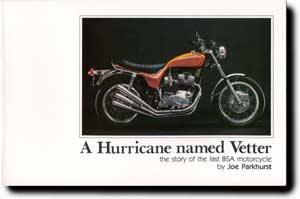 | ||||||||||||||||||||||||||||||||||||||||||||
| What finally happened to the Vetter Rocket 3? | |||||||||||||||||||||||||||||||||||||||||||||
| Mostly, it was parked somewhere in the dark storage corners of Vetter Corporation, first in Illinois and then in California. Internal parts were robbed as friends needed bits and pieces to keep their Triples running. It was like being a "Donor" of healthy body parts. | |||||||||||||||||||||||||||||||||||||||||||||
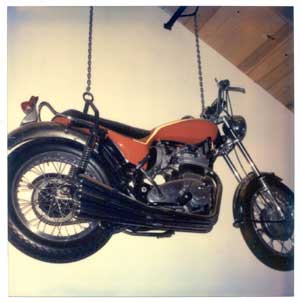 | After I married my wife, Carol, in 1977, and the Vetter Rocket hung in the living room of our new house in San Luis Obispo, California The amazing fact is that we had to place a tray of kitty litter under it because, after ten years, it still leaked oil! | ||||||||||||||||||||||||||||||||||||||||||||
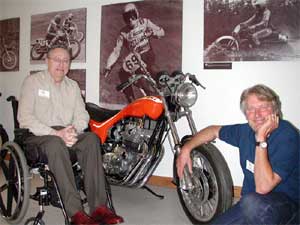 | |||||||||||||||||||||||||||||||||||||||||||||
| Eventually, we donated it to the Motorcycle Hall of Fame Museum in Pickerington, Ohio in December, 1998. Yep, and there is Don Brown being inducted into the AMA Hall of Fame. | |||||||||||||||||||||||||||||||||||||||||||||
| The Hurricane’s fame was growing. In 1998 the Guggenheim selected the Hurricane for The Art of the Motorcycle Exhibition. | |||||||||||||||||||||||||||||||||||||||||||||
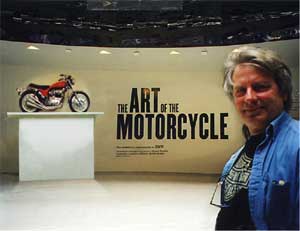 | |||||||||||||||||||||||||||||||||||||||||||||
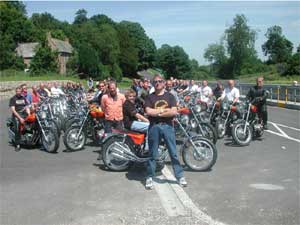 | |||||||||||||||||||||||||||||||||||||||||||||
| Craig reminisces: British enthusiasts took notice of the bike that was never intended for them. In 2001, Bike magazine declared that the X-75 Hurricane was among the 100 greatest bikes ever! British enthusiasts began "mining" the States for Hurricanes. Sixty four showed up at Cadwell Park at the Beezumph 12 Rally in 2003. | |||||||||||||||||||||||||||||||||||||||||||||
| Beezumph 12 in 2002. | |||||||||||||||||||||||||||||||||||||||||||||
| At Beezumph 2003, I learned more about how the Vetter Rocket 3 progressed through the BSA product planning process. An unsung hero named Steve Mettam was apparently given the task of turning the Vetter Rocket 3 into a real, production machine. The story is told in four 1997 issues of the English magazine, Motorcycle Classics. Apparently, Mr. Mettam is the person responsible for the Vetter Rocket 3 becoming the X-75 Triumph Hurricane, while still looking like the original Vetter Rocket 3. My friends at Beezumph did their best to have Mr. Mettam at Beezumph 12, but it was not to happen. I hope some day to meet him in person. Thirty-five years later the bike that Don Brown initiated and I designed has fulfilled all my hopes. Anybody who has a Hurricane is certainly noticed for the right reasons. The Hurricane motorcycle has become recognized around the world for its design. Many are in museums. Who’d have guessed that it would someday be displayed in the Guggenheim? And it is a design that "does more with less." It gets fifty miles per gallon, which is still better than cars (but with that small tank, you’d better find a gas station after 100 miles). Remember, the Hurricane was designed to get girls? I got mine. Carol and I are happily married with two wonderful boys, Zak and Morgan. What more could a man ask for? Thank you Don. | |||||||||||||||||||||||||||||||||||||||||||||
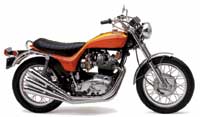 | |||||||||||||||||||||||||||||||||||||||||||||
| End as of June 25, 2004 | |||||||||||||||||||||||||||||||||||||||||||||








